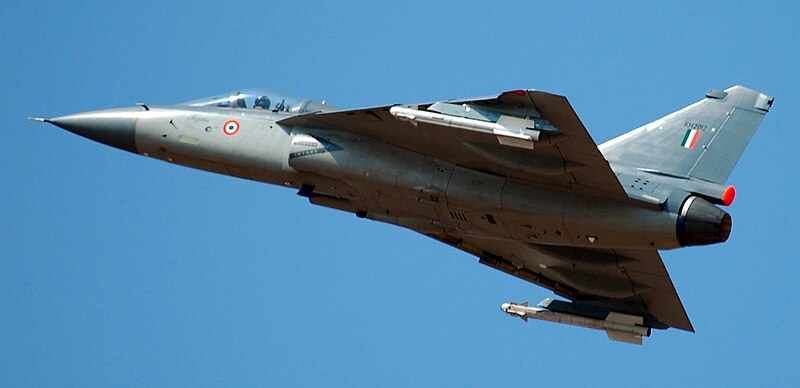
The HAL Tejas is a lightweight multirole jet fighter developed by India. It is a tailless, compound delta wing design powered by a single engine. It came from the Light Combat Aircraft (LCA) programme, which was begun in the 1980s to replace India's aging MiG-21 fighters. Later the LCA was officially named "Tejas" by then Prime Minister Atal Bihari Vajpayee.
The Tejas has the delta wing configuration, with no tailplanes or foreplanes, features a single vertical fin. It integrates technologies such as relaxed static stability, fly-by-wire flight control system, advanced digital cockpit, multi-mode radar, integrated digital avionics system, advanced composite material structures and a flat rated engine.
The IAF is reported to have a requirement for 200 single-seat and 20 two-seat conversion trainers, while the Indian Navy may order up to 40 single-seaters to replace its Sea Harrier FRS.51 and Harrier T.60. During its sea level flight trials off Goa, Tejas notched a speed of over 1,350 km per hour, thus becoming the second supersonic fighter manufactured indigenously by Hindustan Aeronautics Limited after the HAL Marut. The Tejas was cleared in January 2011 for use by Indian Air Force pilots.
Specifications (HAL Tejas)

- Crew: 1
- Length: 13.20 m (43 ft 4 in)
- Wingspan: 8.20 m (26 ft 11 in)
- Height: 4.40 m (14 ft 9 in)
- Wing area: 38.4 m² (413 ft²)
- Empty weight: 6,560 kg (14,460 lb)
- Loaded weight: 10,500 kg (23,100 lb)
- Max takeoff weight: 13,300 kg (29,540 lb)
- Powerplant: 1 × General Electric F404-GE-IN20 turbofan
- Dry thrust: 53.9 kN (11,250 lbf)
- Thrust with afterburner: 85 kN (19,000 lbf)
- Internal fuel capacity: 2,458 kg
- External fuel capacity: 2x 1,200 litre drop tank at inboard, 1x 725 litre drop tank under fuselage
- Maximum speed: Mach 1.8 (2,376+ km/h at high altitude) at 15,000 m
- Range: 3,000 km (1,840 mi) without refueling
- Service ceiling: 15,250 m (50,000 ft (engine re-igniter safely capable))
- Wing loading: 221.4 kg/m² (45.35 lb/ft²)
- Thrust/weight: 0.91
- g-limits: +9/−3.5 g
- Guns: 1× mounted 23 mm twin-barrel GSh-23 cannon with 220 rounds of ammunition.
- Hardpoints: 8 total: 1× beneath the port-side intake trunk for targeting pods, 6× under-wing, and 1× under-fuselage with a capacity of 4000 kg external fuel and ordnance
Missiles:
- Air-to-air missiles:
- Python 5
- Derby
- Astra BVRAAM
- Vympel R-77 (NATO reporting name: AA-12 Adder)
- Vympel R-73 (NATO reporting name: AA-11 Archer)
- Air-to-surface missiles:
- Kh-59ME TV guided standoff Missile
- Kh-59MK Laser guided standoff Missile
- Anti-ship missile
- Kh-35
- Kh-31
- KAB-1500L laser guided bombs
- GBU-16 Paveway II
- FAB-250
- ODAB-500PM fuel-air explosives
- ZAB-250/350 incendiary bombs
- BetAB-500Shp powered concrete-piercing bombs
- FAB-500T dumb bombs
- OFAB-250-270 dumb bombs
- OFAB-100-120 dumb bombs
- RBK-500 cluster bombs
- S-8 rocket pods
- Bofors 135 mm rocket launche
- Drop tanks for ferry flight/extended range/loitering time.
- LITENING targeting pod
Avionics
Hybrid MMR radar (Israeli EL/M-2032 back end processor with Indian inputs)



No comments:
Post a Comment